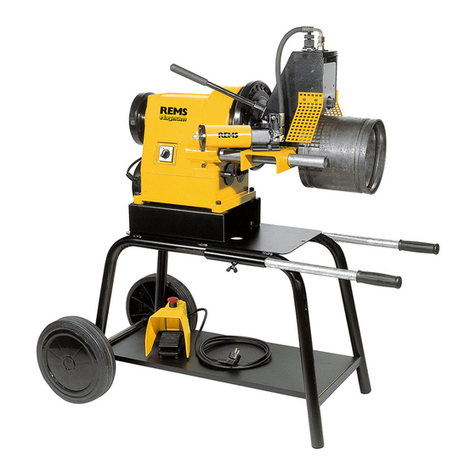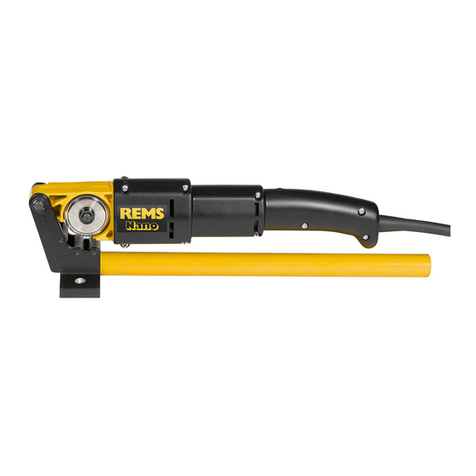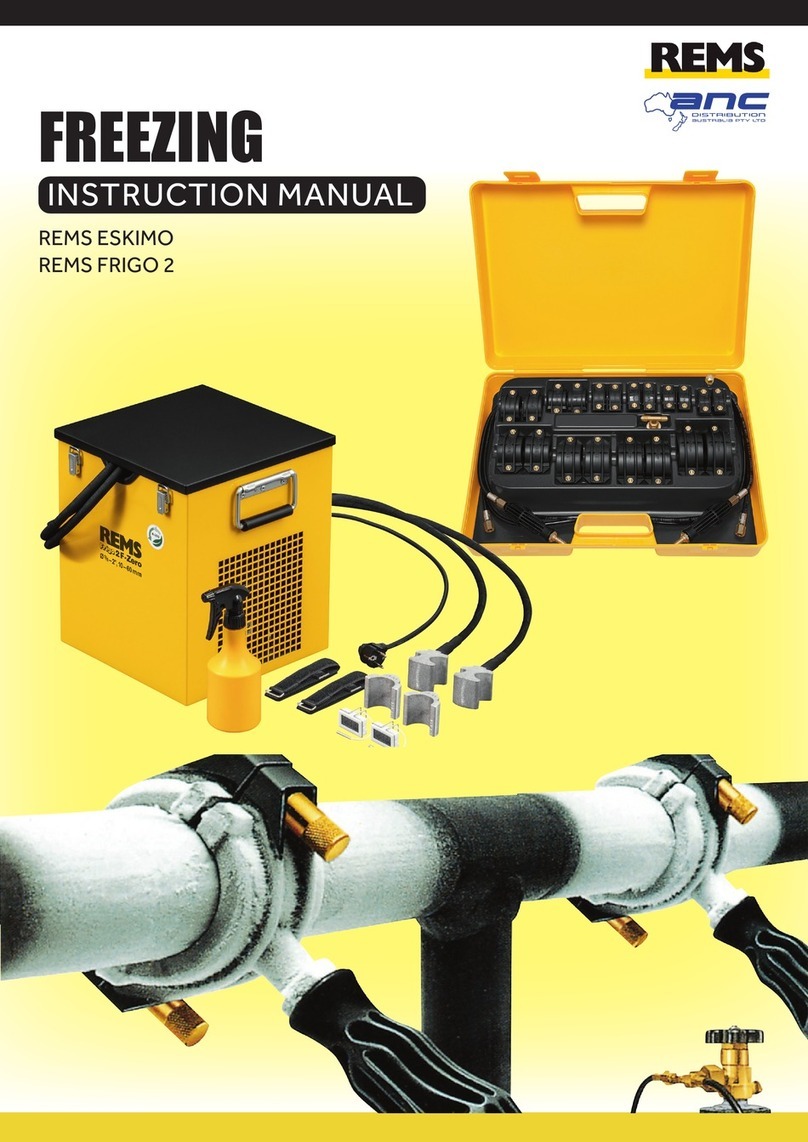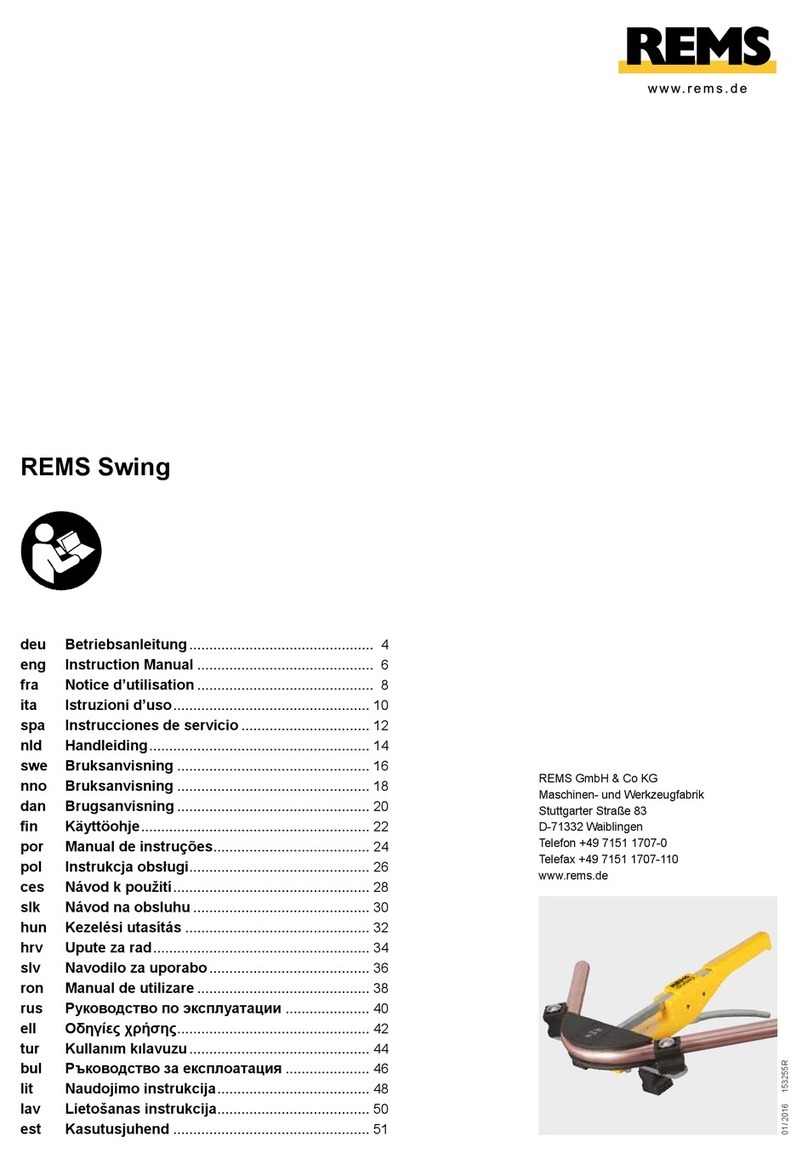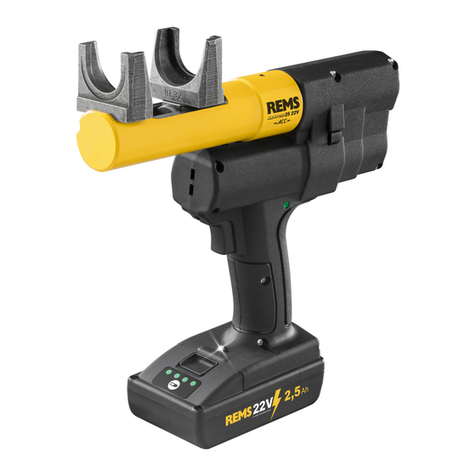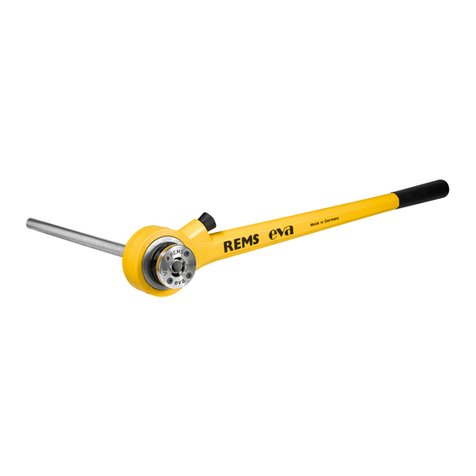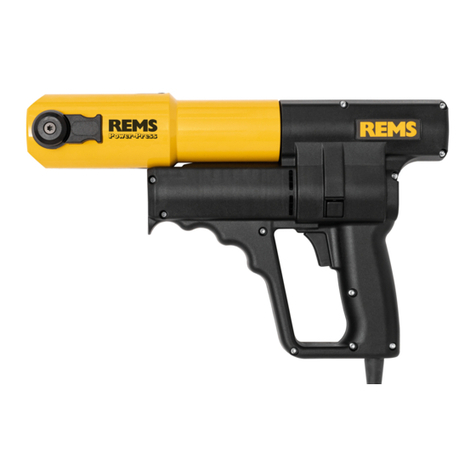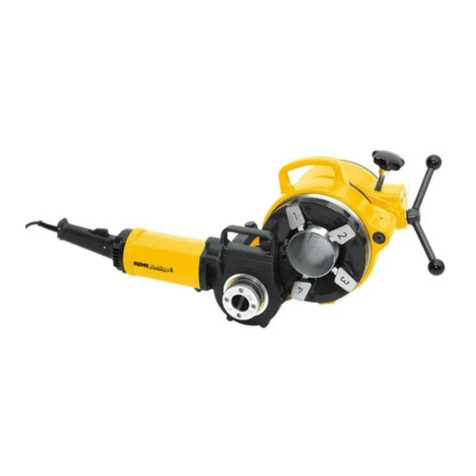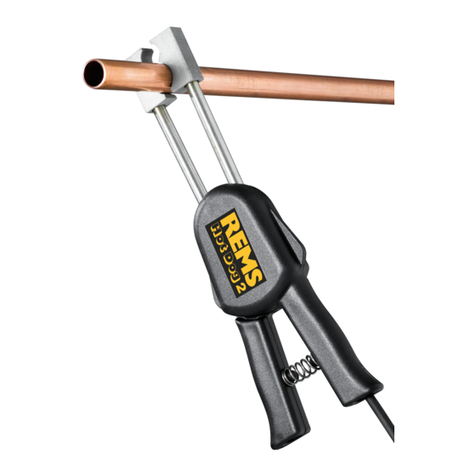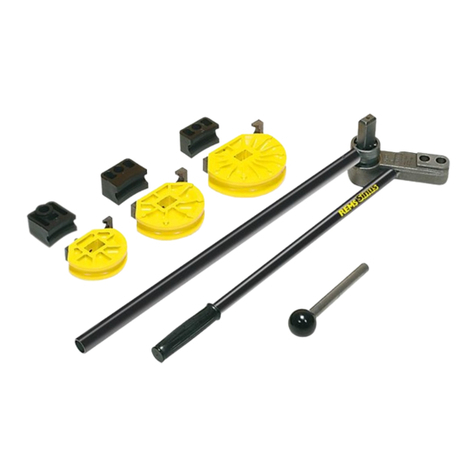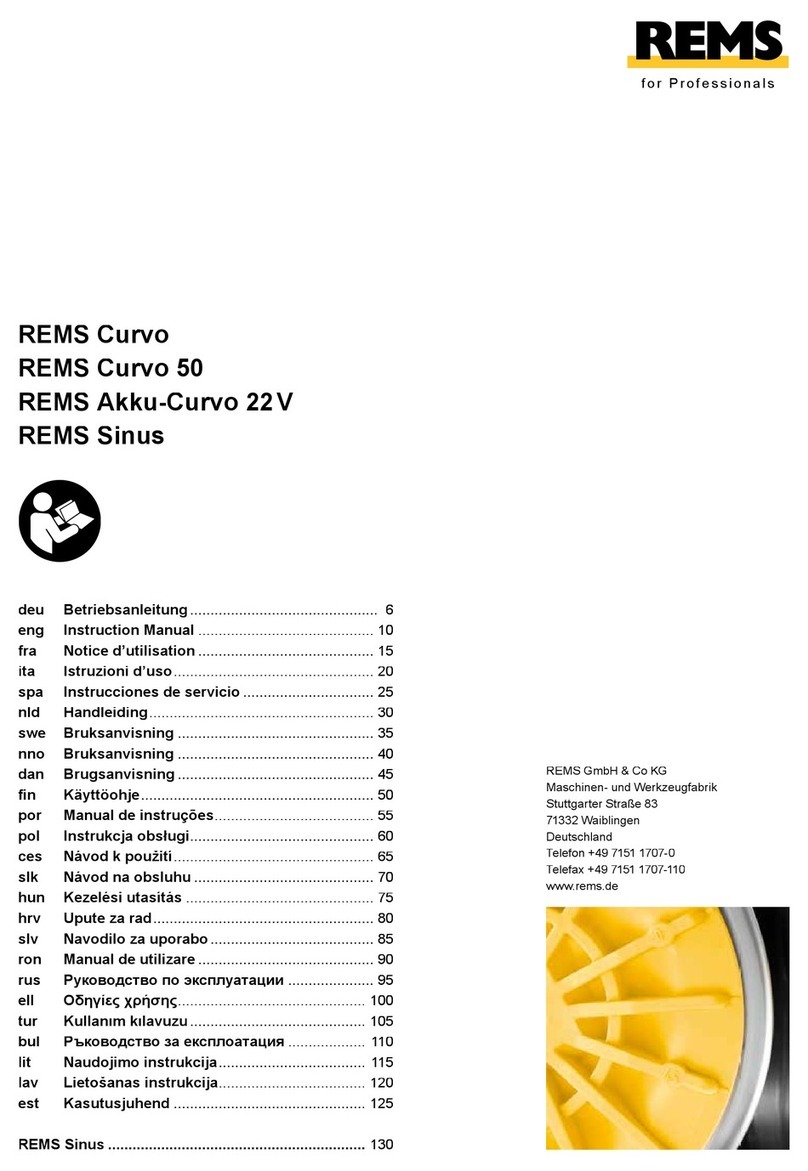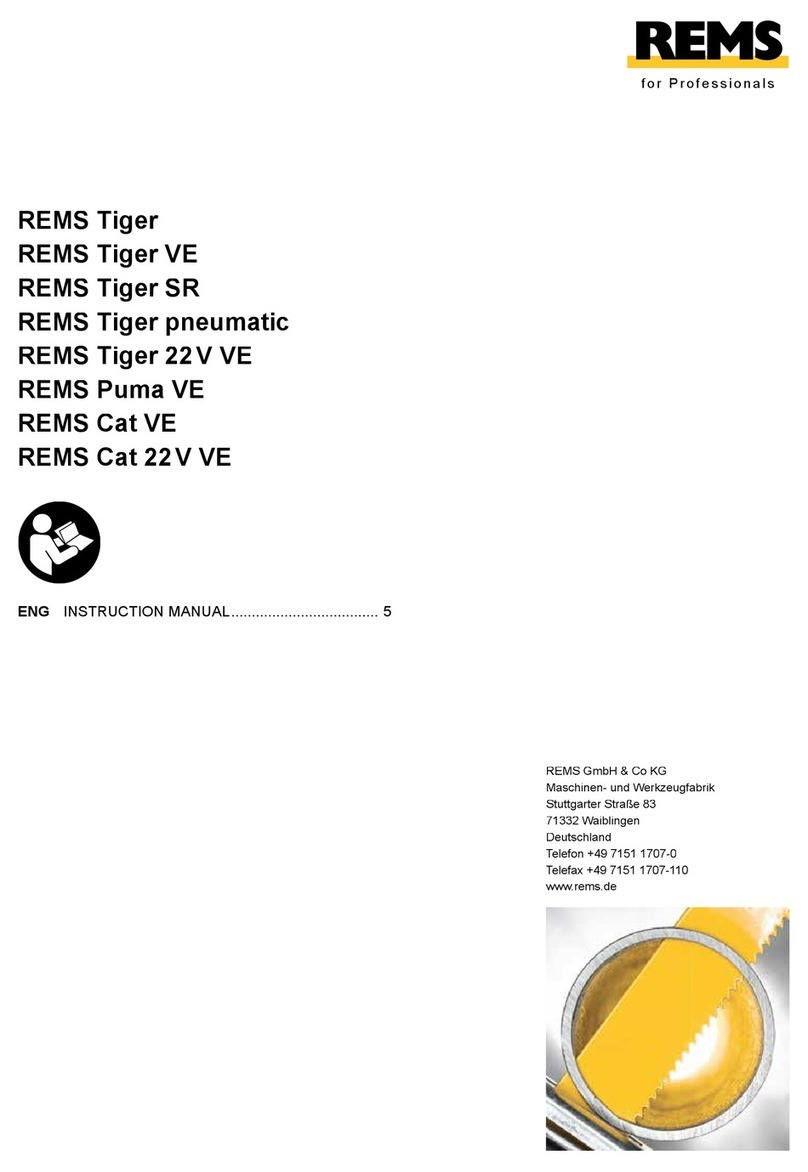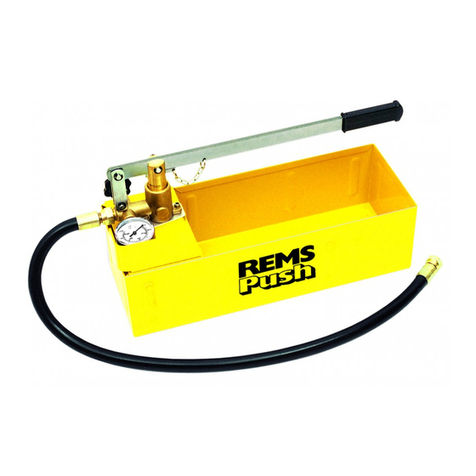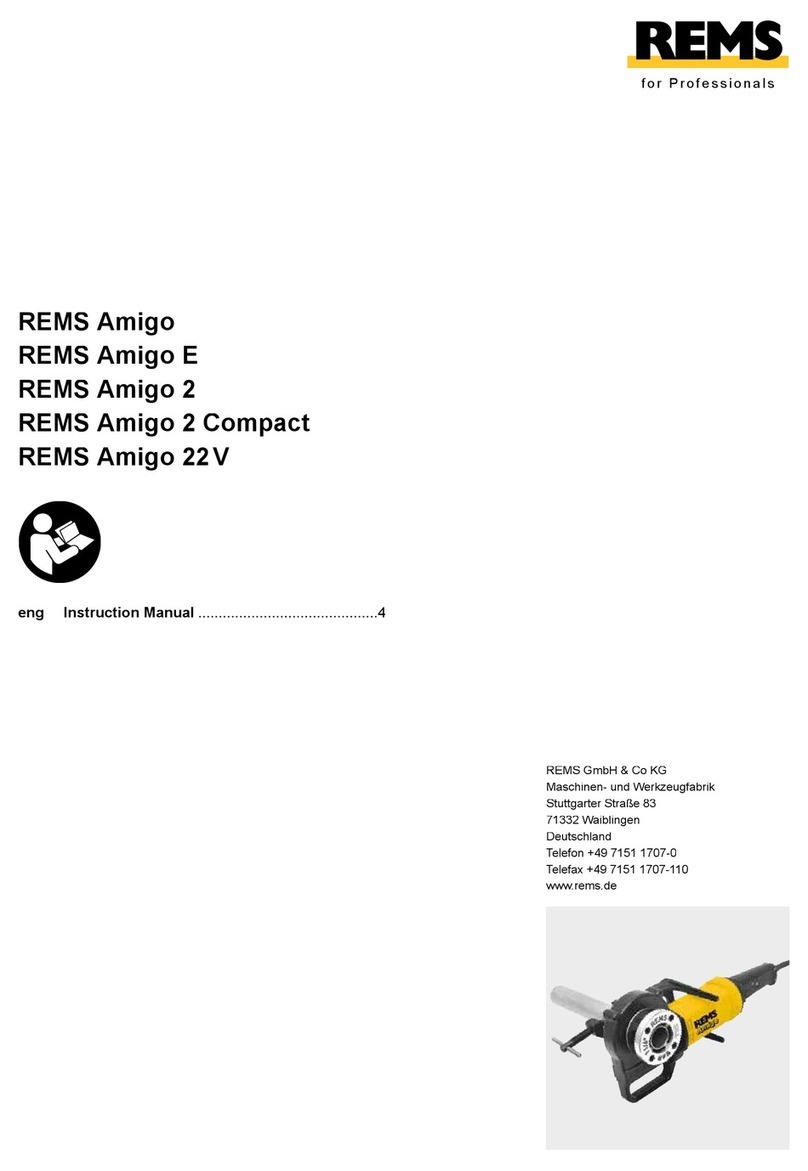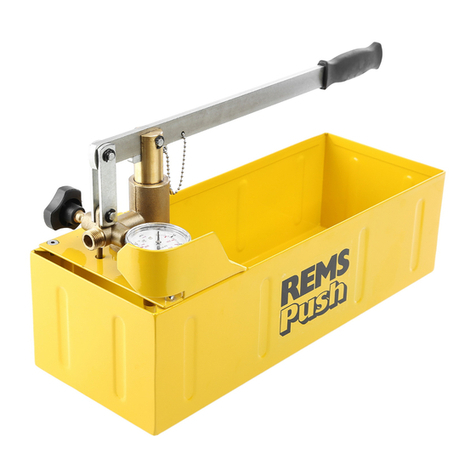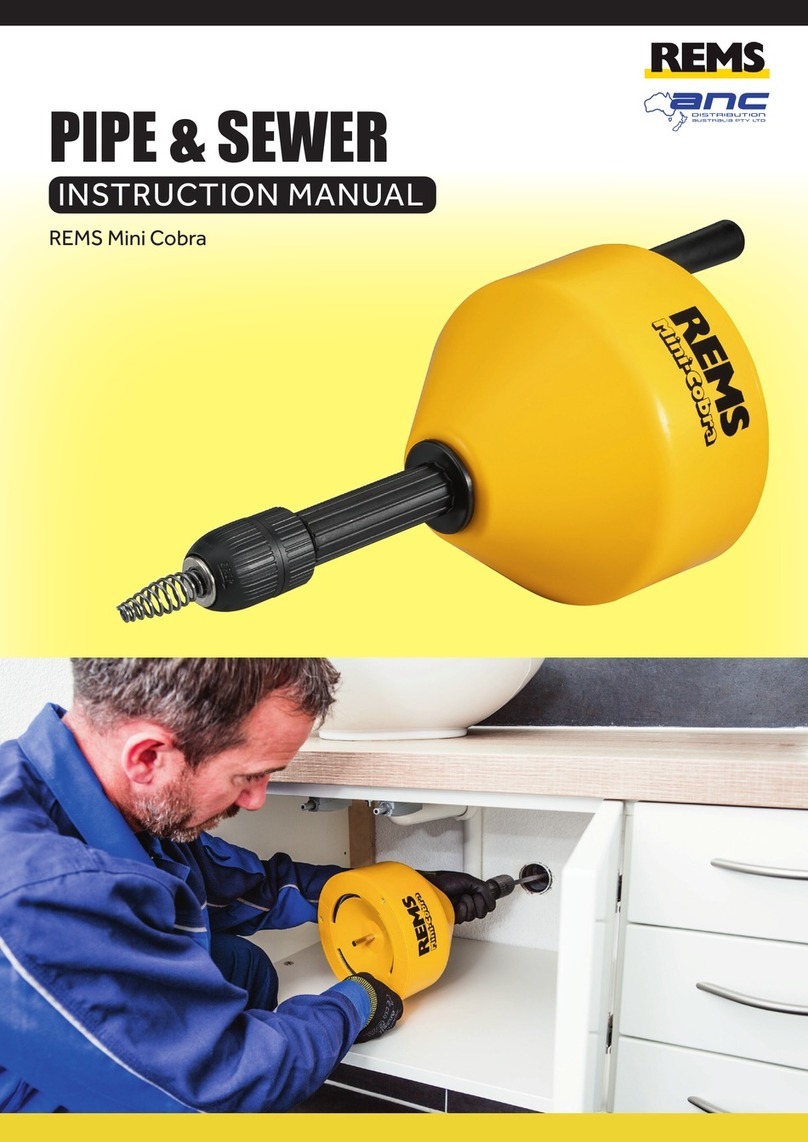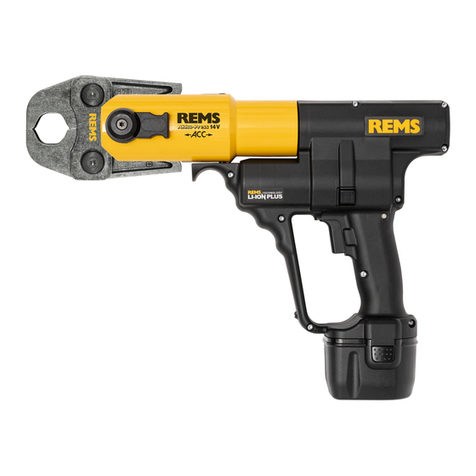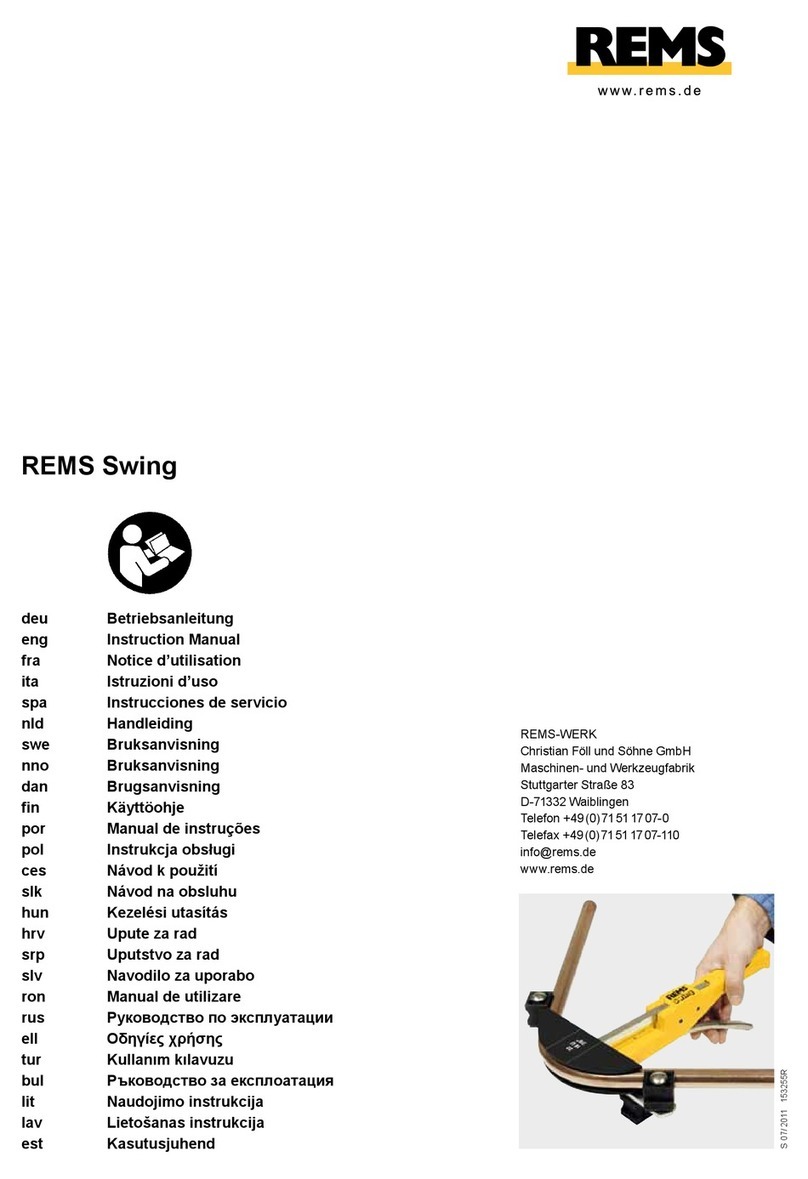
7
2.2.
changing) the pressing heads (
5
) in axial presses (Figs.
1, 2
Remove the battery. Only use system-specifi c pressing heads. REMS press ing
identify the compression sleeve syste
to identify the size. Read and observe the
installation and assembly instructions
of the manufacturer/supplier of the used compression sleeve system. Never
use non-matching pressing heads (compression sleeve system, size) for
pressing work. The press joint could be unserviceable, and both the machine
and the pressing heads might be damaged.
Push the selected pressing heads (
5
) right in, if necessary turning them until
they engage (ball catch). Keep the pressing heads and locating hole inside the
3
hanging) the expanding head (
7
4
Pull out the mains plug. Read and observe th
e installation and assembly
instructions of the manufacturer/supplier of the used system. Never use non-
matching expanding heads (s
ystem, size) for expansion work. The joint could
be unserviceable, and both the machine and the expanding heads might be
damaged. Grease the cone of the expanding mandrel (
9
selected expanding head as far as it will go onto the expander. Read and
observe the installation and assembly instructions of the manufacturer/supplier
REMS P and Cu expanding heads are unsuitable for the
REMS Power-Ex-Press P-CEF ACC and may therefore not be used..
Changing the expanding device on the REMS Power-Ex-Press P-CEF ACC
Pull out the mains plug. Unscrew the expanding device
(6)
Power-Ex-Press P-CEF ACC. Screw on the selected ex
4
. Assembly (changing) of the expander
(6)
(7)
S
E
3
(6)
to match the expanding head
(7)
Cu for the REMS Cu expanding heads. Use the expander P for the REMS P
expanding heads. Use the P-CEF expander for the REMS expanding heads.
Only use system-specifi c expanding heads. REMS P and REMS P-CEFexpanding
heads are labelled with letters to identify the compression sleeve system and
a number to identify the size, REMS Cu expanding heads only with a number
to identify the size. Read and observe the installation and assembly instructions
of the manufacturer/supplier of the used system. Never expand with an unsuit-
able expander, unsuitable expanding heads (system, size). The joint could be
useless and the machine and expanding heads could be damaged.
the cone of the expanding mandrel
(9)
Changing the P and Cu expander
elected expanding head onto the expanding device
(6)
The expanding device must now be set so t
hat the thrust of the drive machine
is taken up by the drive machine and not the expanding head at the end of the
expanding. Unscrew the expanding device
(6)
expanding head from the drive machine for this. Let the feed piston run forward
as far as possible without
the machine switching into reverse. In this position
the expander with screwed-on expanding head must be screwed onto the drive
unit until the expanding jaws
(8)
(7)
secured with the locking nut
(11)
NOTICE
Make sure that the compression sleeve is far enough away from the expanding
(7)
in the expanding process because otherwise the expanding jaws
(8)
Changing the P-CEF expander
Remove the battery. Screw on the locking nut
(11)
and the selected expander
(6)
up to the stop. Screw the selected expanding head
(7)
After the drive unit has been in storage for a long period of time, the overpressure
valve must be actuated fi rst by pressing the reset button (13) before putting back
into operation. If it is stuck or stiff, it may not be pressed. The drive unit must be
handed over to an authorized REMS customer service workshop for inspectio
n.
3.1. A
1, 2
Note the different working range of the axial presses. The respectively latest
REMS sales literature applies, see also
Catalogues, Brochures. Make sure that the pressing heads (
5
into the drive unit in such a way that the pressing can be made in one stroke
if possible. This is not possible in some cases and pre-pressing and fi nish
pressing is necessary. For this, one pressing head or both pressing heads must
be inserted turned 180° before the second pressing process so that they are
Working procedure
Danger of cru shing! Keep your hands away from the moving pressing
heads (5)!
In REMS Ax-Press 30 22 V (Fig. 2) , place the preassembled compression
sleeve fi tting inside the pressing heads (5). Hold the drive unit by the housing
grip (1) and the pistol grip (3), and keep the safety inching switch (2) pressed
until the compression sleeve is in contact with the collar of the compression
sleeve fi tting This is indicated by an acoustic signal (click). Hold the reset button
(4) until the pressing heads (5) have moved back completely.
In REMS Ax-Press 25 22 V ACC, REMS Ax-Press 25 L 22 V ACC (Fig. 1), place
the preassembled compression sleeve fi tting inside the pressing heads (5).
the REMS Ax-Press 25 L ACC the closer distance of the pressing heads may
oving the outer pressing head into the centre pressing
head position. Hold the drive machine either with one hand on the switch handle
(3)
or two hands on the housing handle
(1)
(3)
(2)
pressed until the compression sleeve is touching the
collar of the compression sleeve connector. The drive machine then switches
automatically to return (forced return).
If there is a noticeable gap between the compression sleeve and the collar of
the compression sleeve connector after closing the compression heads, the
pressing may be faulty or leaking (see 5. Faults). Read and observe the instal-
lation and assembly instructions of the manufacturer/supplier of the pressing
sleeve system to be pressed.
With the compression sleeve system IV, various pressing heads are needed
for one pipe size. Consult and comply with the instructions for installation and
fi tting of the system’s man
2
Working procedure
In REMS Ex-Press 22 V ACC with expander Cu (Fig. 3), insert the expanding
head into the pipe up to the stop and press the expanding head/drive unit
against the pipe.
Switch on the drive unit. If the expanding head is open, the
drive unit switches automatically to return and the expanding head is closed
again. Read and observe the installation and assembly instructions of the
manufacturer/supplier of the used system.
In REMS Ex-Press 22 V ACC with expander P (Fig. 3), push the compression
sleeve over the pipe, insert the expanding head into the pipe up to the stop
and press the expanding head/drive unit against the pipe.
unit. Make sure that the compression sleeve is far enough away from the
expanding head in the expanding process because otherwise the expanding
(8)
can bend or break. Keep the safety inching switch
(2)
the pipe is expanded. This is indicated by an acoustic signal (click). Expand
several times if necessary. Turn the pipe slightly. Read and observe the instal-
lation and assembly instructions of the manufacturer/supplier of the used system.
In REMS Ex-Press 22 V ACC with expander P-CEF, REMS Power-Ex-Press
P-CEF ACC (Fig. 3, 4), p
ush a ring of the appropriate size onto the pipe. Insert
sion head into the pipe and press the expanding head/drive unit
against the pipe. Switch on the drive unit. When the expanding head is opened,
ve unit switches automatically to return and the expanding head is closed
again. Keep holding the safety inching switch
(2)
S E
ACC and push the expanding head/drive unit further. Turn the pipe slig
Keep repeating the expansion process until the expanding jaws
(8)
On REMS Power-Ex-Press P-CEF ACC, release the
(2)
after every expanding process, wait until the expanding
mandrel has moved back completely, turn the pipe, then press the safety inching
(2)
again. Repeat the expanding process until the expanding jaws
(8)
are pushed into the pipe up to the stop. Read and observe the installation and
assembly instructions of the manufacturer/supplier of the used system.
3.3. Safety during operation
Functional safety
REMS Ax-Press 30 22 V ends the pressing operation automatically, emitting
an acoustic signal (clicking).
REMS Ax-Press 25 22 V ACC, REMS Ax-Press 25 L 22V ACC and REMS
Ex-Press 22 V ACC end the pressing operation automatically, emitting an
acoustic signal (clicking) and return automatically (automatic circuit control).
Working safety
To ensure safe working, the drive units are equipped with a safety inching switch
(2). This permits immediate switching off of the drive units at any time, particu-
larly if a potential hazard arises. The drive units can be switched to the return
function in any position.
Machine status check with fl at battery protection
All REMS Akku presses have been equipped with an electronic machine status
check with charging level indicator (10) with a 2-coloured green/red LED since
01/01/2011.
The LED lights green when the battery is fully or still suffi ciently
charged. The LED lights red when the battery must be charged. If this condition
occurs during pressing and the pressing process is not fi nished, the pressing
must be completed with a fully charged Li-Ion battery. If the drive unit is not
used, the LED goes out after approx. 2 hours but comes on again when the
drive unit is switched back on.
3.5. Graduated charging level indicator
(13)
of the Li-Ion 21.6 V battery
The graduated charging level indicator show
s the charging level of the battery
with 4 LEDs. At least one LED lights for a few seconds after pressing the key
with the battery symbol. The more
LEDs that light green, the higher the charging
level of the battery. If a LED fl ashes
ed.
